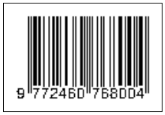Suhu Pemanas Sampel Optimal Untuk Klasifikasi Teh Hitam Menggunakan Electronic Nose
Danang Lelono(1*), Kuwat Triyana(2)
(1) (Scopus ID : 35728748100); Department of Computer Science and Electronics, Gadjah Mada University
(2) Departemen Fisika, FMIPA, UGM, Sekip Utara BLS 21 Yogyakarta
(*) Corresponding Author
Abstract
The optimization of heating temperature of black tea samples for the measurement of aroma with electronic nose (e-nose) has been successfully performed. Sample heating is done because black tea has a low aroma intensity and easily lost. However, the selection of such temperature should be selective because it can result in damage to the aroma of the sample. Therefore, temperature optimization needs to be done so that the resulting sensor response comes from the transformation of the undamaged aroma.
The method used to obtain the optimum heating temperature by analyzing the sensor response of the aroma transformation that is captured by e-nose. Consistency and pattern changes formed from the sensor response are used as a comparison of optimal heating temperature selection. The measured sample varied in temperature (30 - 60 °C) so that the resulting sensor response was observed. Change in patterns indicate the aroma has been burning. After optimal temperature is obtained then black tea (50 gr) Broken Orange Pokoe, Broken Pokoe II and Bohea with a total sample of 300 bags were measured with e-nose. For further analysis, the result of classification by method of Principal Component Analysis (PCA) as proof of sample heating temperature optimization successfully done.
The experimental results show optimal sample heating for black tea 3 quality 40 - 45 °C. After then with the third PCA the sample can be classified up to 92.5% of the total data variant. This indicates the aroma of tea is relatively constant and there is no pattern change.
Keywords
Full Text:
PDFReferences
[1] D. Lelono, K. Triyana, S. Hartati, and J. E. Istiyanto, “Classification of Indonesia black teas based on quality by using electronic nose and principal component analysis,” 2016, p. 020003.
[2] M. Ghasemi-Varnamkhasti, C. Apetrei, J. Lozano, and A. Anyogu, “Potential use of electronic noses, electronic tongues and biosensors as multisensor systems for spoilage examination in foods,” Trends Food Sci. Technol., vol. 80, no. March, pp. 71–92, 2018.
[3] M. Ezhilan, N. Nesakumar, K. J. Babu, and C. S. Srinandan, “An Electronic Nose for Royal Delicious Apple Quality Assessment – A Tri- layer Approach,” Food Res. Int., vol. 109, no. December 2017, pp. 44–51, 2018.
[4] F. Sun, Z. Wu, Y. Chen, J. Li, S. He, and R. Bai, “Analysis of odors from thermally modified bamboo assessed by an electronic nose,” Build. Environ., vol. 144, no. May, pp. 386–391, 2018.
[5] A. Blanco-Rodríguez et al., “Development of an electronic nose to characterize odours emitted from different stages in a wastewater treatment plant,” Water Res., vol. 134, pp. 92–100, 2018.
[6] A. Sanaeifar, S. S. Mohtasebi, M. Ghasemi-Varnamkhasti, and H. Ahmadi, “Application of MOS based electronic nose for the prediction of banana quality properties,” Meas. J. Int. Meas. Confed., vol. 82, pp. 105–114, 2016.
[7] P. Sharma et al., “Monitoring the fermentation process of black tea using QCM sensor based electronic nose,” Sensors Actuators, B Chem., vol. 219, pp. 146–157, 2015.
[8] D. R. Wijaya, R. Sarno, E. Zulaika, and S. I. Sabila, “Development of mobile electronic nose for beef quality monitoring,” Procedia Comput. Sci., vol. 124, pp. 728–735, 2017.
[9] F. Nisa, “Pengukuran Konsentrasi Aroma Sample Teh Hitam Menggunakan Electronic Nose dengan Melakukan Variasi Suhu,” Universitas Gajdah Mada, 2018.
[10] B. Tudu, S. Ghosh, A. K. Bag, D. Ghosh, N. Bhattacharyya, and R. Bandyopadhyay, “Incremental FCM Technique for Black Tea Quality Evaluation Using an Electronic Nose,” Fuzzy Inf. Eng., vol. 7, no. 3, pp. 275–289, 2015.
[11] K. Triyana, A. Masthori, B. P. Supardi, M. Iqbal, and A. Bharata, “Prototype of Electronic Nose Based on Gas Sensors Array and Back Propagation Neural Network for Tea,” J. Math. Nat. Sci., vol. 17, no. 3, pp. 57–62, 2007.
[12] D. Lelono, K. Triyana, S. Hartati, and J. E. Istiyanto, “Development of Electronic Nose with Highly Stable Sample Heater to Classify Quality Levels of Local Black Tea,” Int. J. Adv. Sci. Eng. Inf. Technol., vol. 7, no. 2, pp. 352–358, 2017.
[13] J. Yan et al., “Electronic Nose Feature Extraction Methods: A Review,” Sensors, vol. 15, no. 11, pp. 27804–27831, 2015.
[14] E. L. Hines, P. Boilot, J. W. Gardner, and M. A. Gongora, “Pattern Analysis for Electronic Noses,” in Handbook of Machine Olfaction, Wiley-VCH Verlag GmbH & Co. KGaA, 2004, pp. 133–160.
Article Metrics
Refbacks
- There are currently no refbacks.
Copyright (c) 2019 IJEIS (Indonesian Journal of Electronics and Instrumentation Systems)

This work is licensed under a Creative Commons Attribution-ShareAlike 4.0 International License.
View My Stats1







